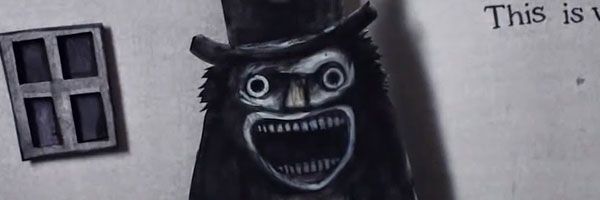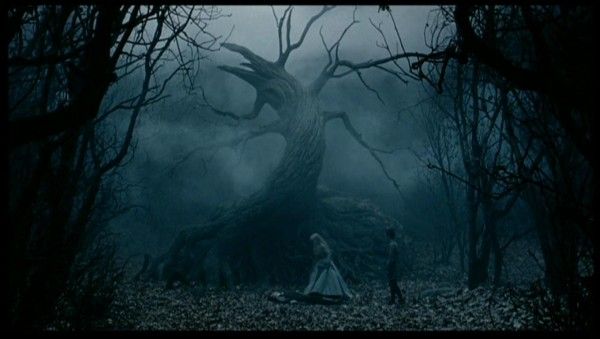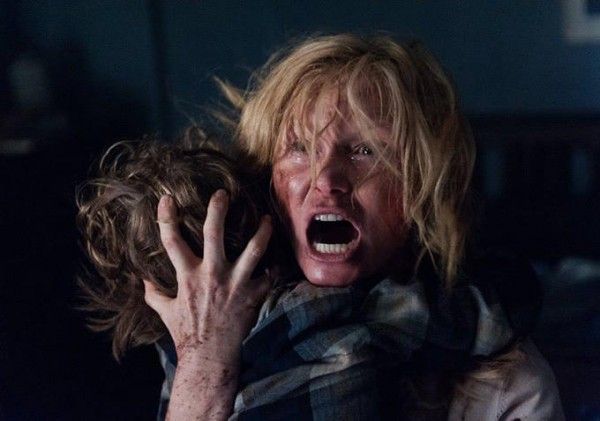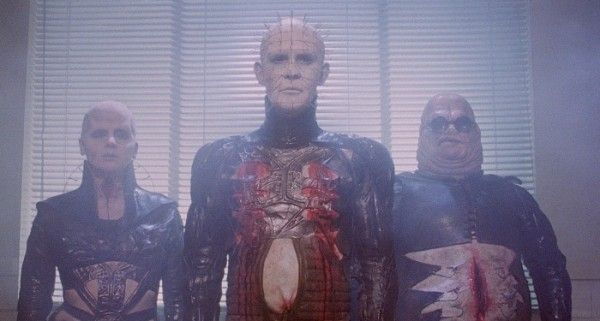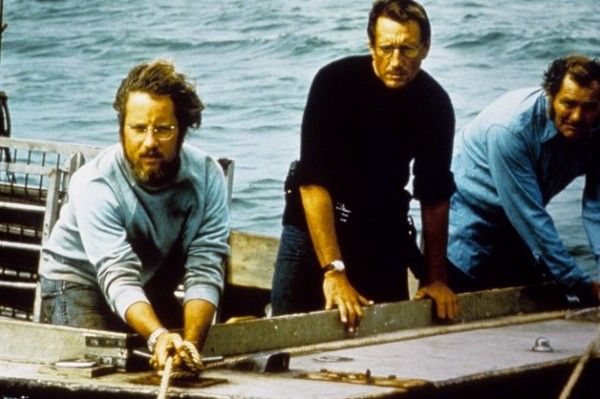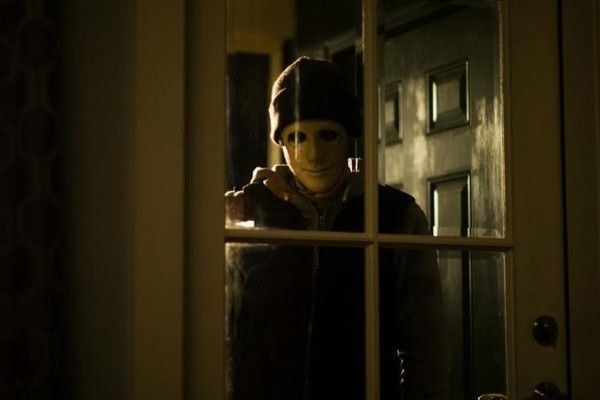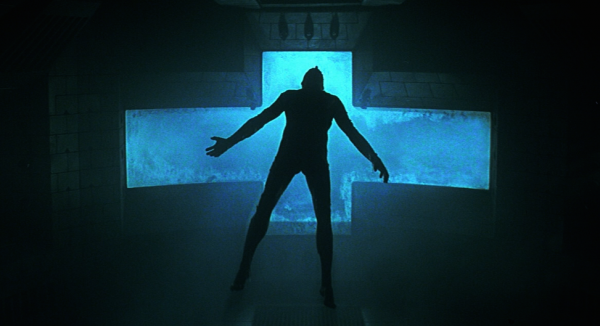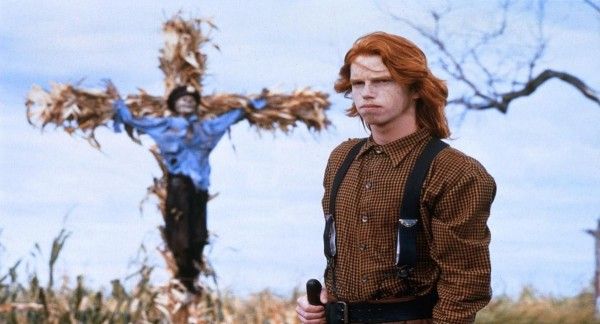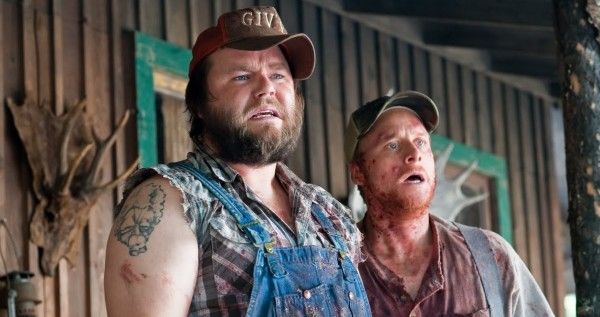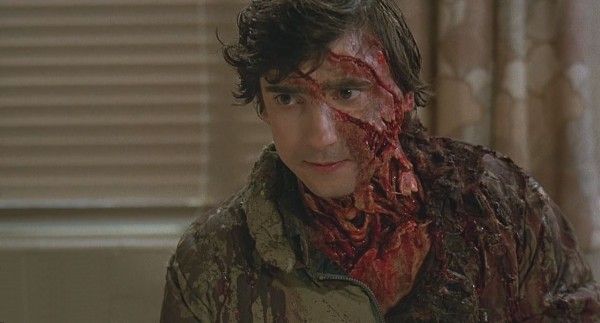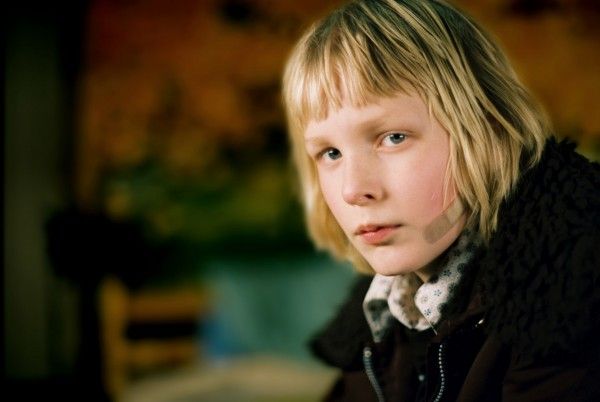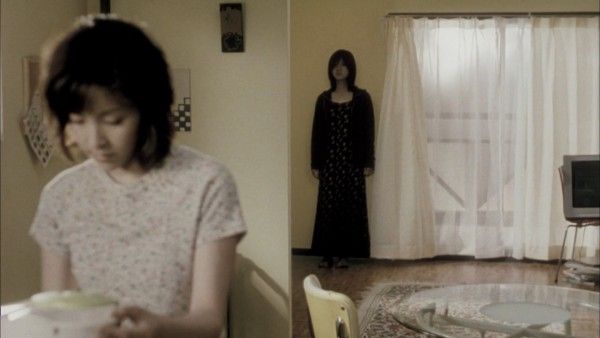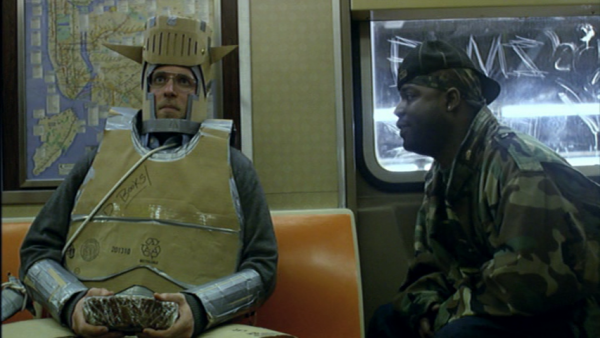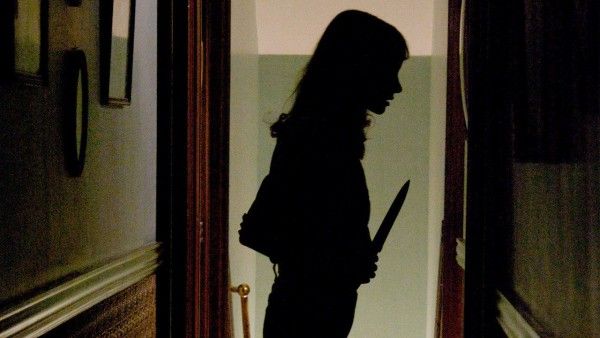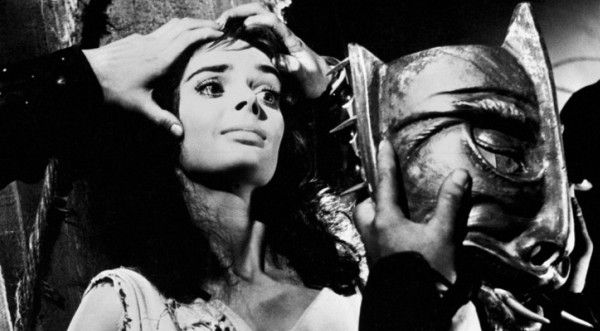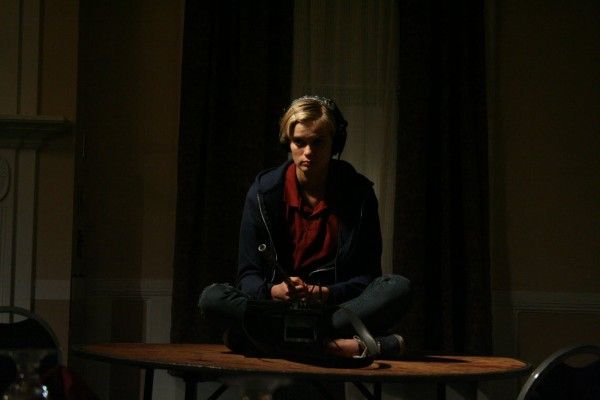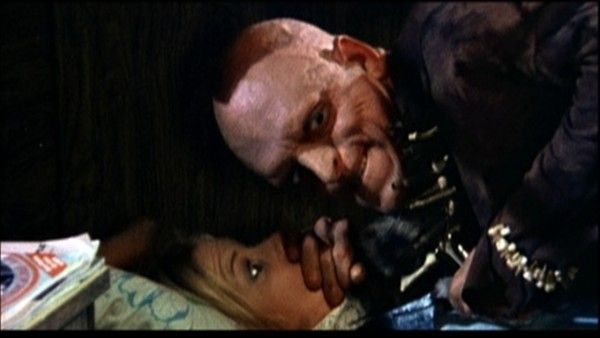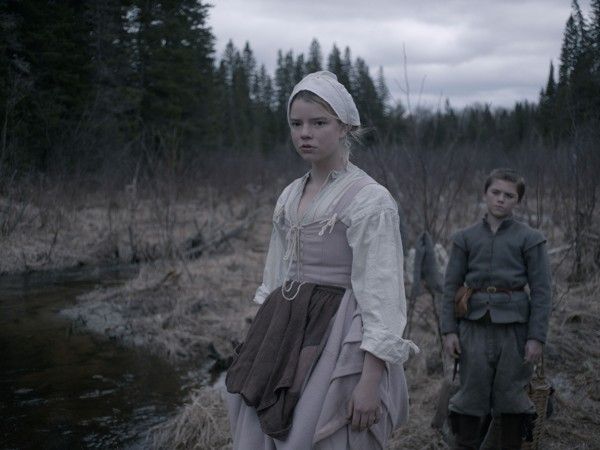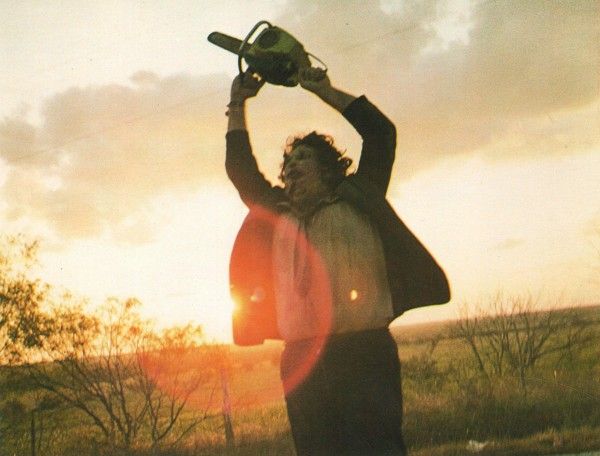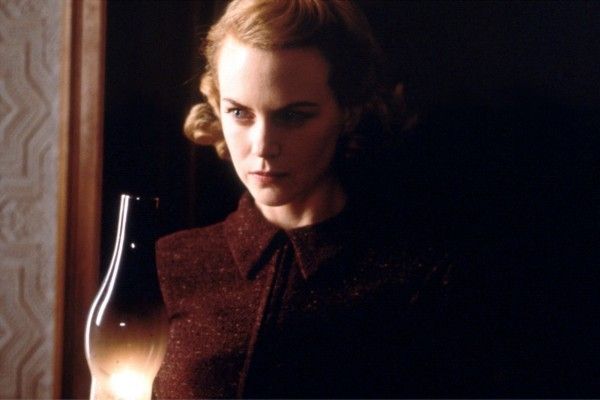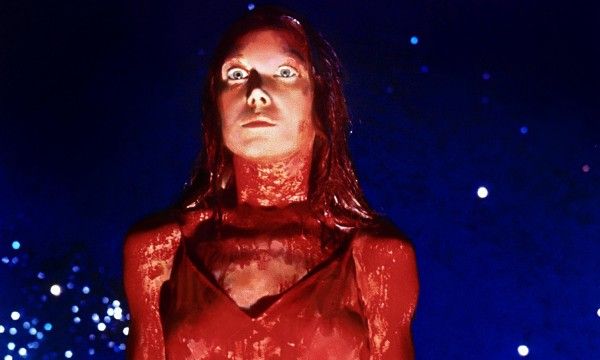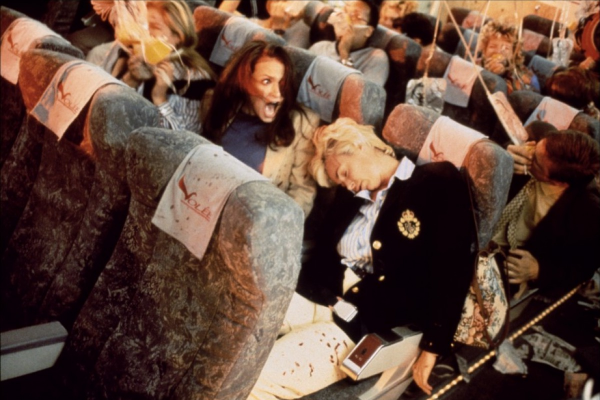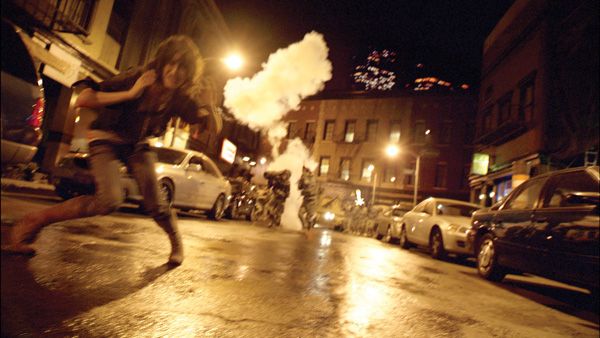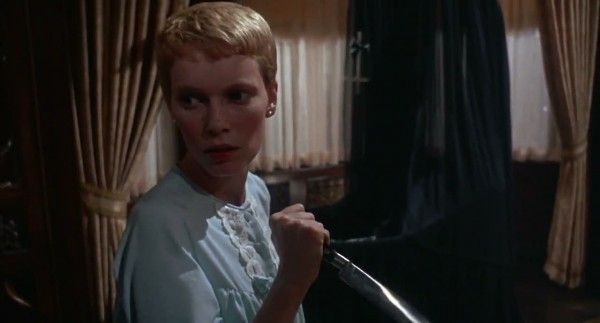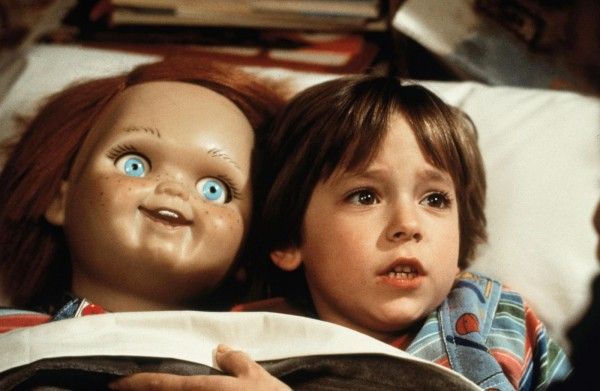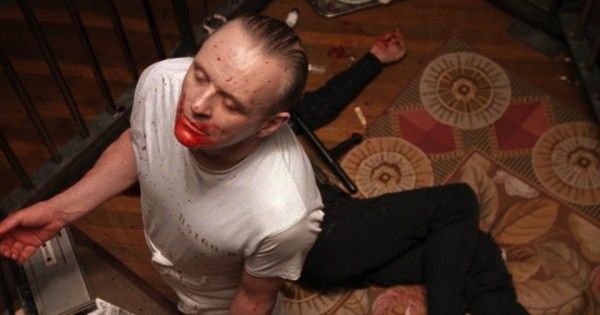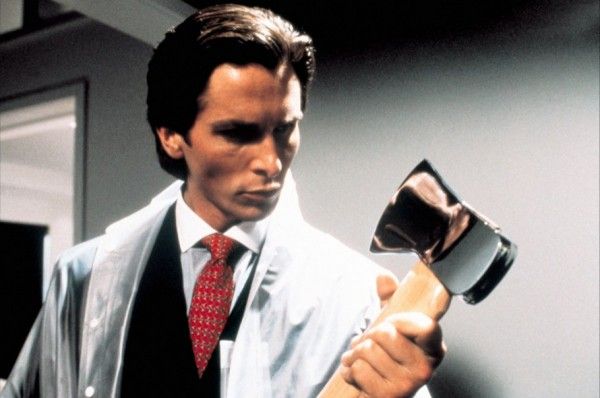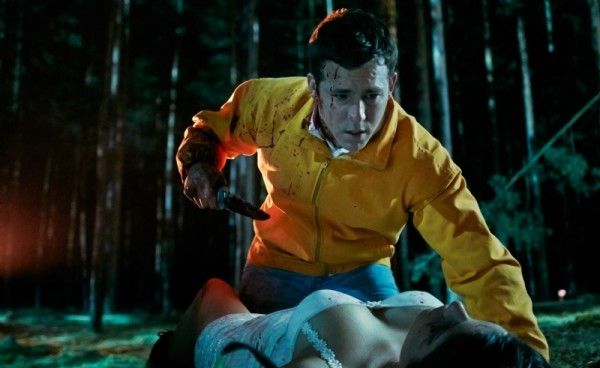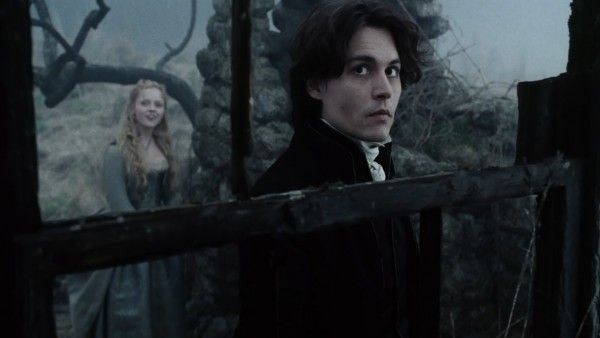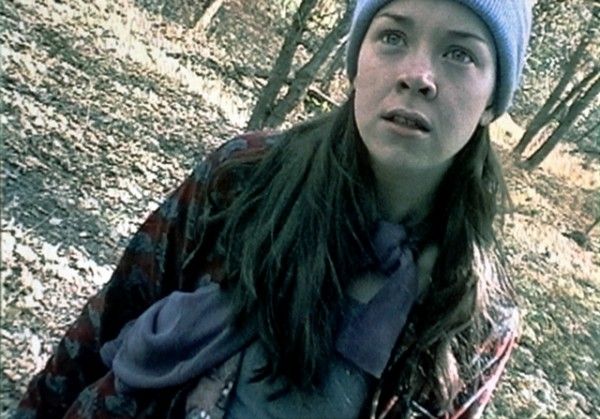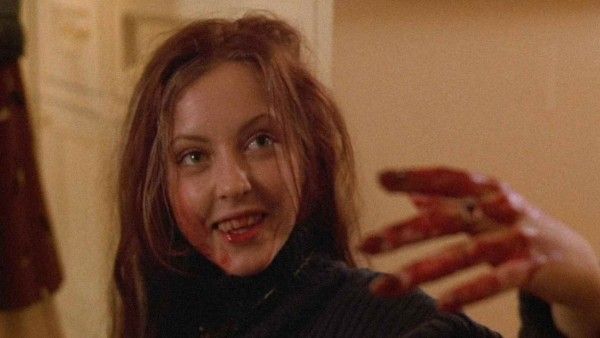It's the Friday night before Halloween, which means we are officially in the golden period of annual horror movie watching. Maybe you've got a set list of films you like to watch every year (guilty as charged, here), or maybe you're a more adventurous watcher. Either way, there' are plenty of horror gems you can stream right now for a little All Hallow's Eve thrill.
Below I've put together a list of some of the best horror titles you can stream right now on Netflix, Hulu, Amazon, and Shudder. While Netflix's horror catalogue has taken a noticeable hit since they started scaling back on streaming deals in favor of original content, they've still got a few classics and contemporary gems on there and I've picked out a few of the best below. If you're looking for more horror on Netflix specifically, be sure to check out our running collection of the best horror movies on Netflix.
As far as Amazon and Hulu, both have a respectable combination of old and new favorites (even with a noticeable overlap) and with the Criterion Collection heading off to FilmStruck soon, now's the perfect time to catch some of those chilling classics before they drop off. But there's no doubt that Shudder is the mac daddy of horror streaming options. Dedicated specifically to the horror genre, Shudder boasts a near 500 titles and thanks to careful curation by the service's team of experts, there's a reliable quality to the library.
But there's no doubt that Shudder is the mac daddy of horror streaming options. Dedicated specifically to the horror genre, Shudder boasts a near 500 titles and thanks to careful curation by the service's team of experts, there's a reliable quality to the library. I grew up in the Blockbuster generation when tracking down rare or explicit films wasn't always a walk in the park, so it's pretty cool to see some of the titles I used to hunt down readily available at my fingertips.
Without further ado, check out the best streaming horror movies for the Halloween season below.
Netflix
The Babadook
Being a parent is tough. It’s even tougher when you’ve accidentally unleashed The Babadook, a malevolent spirit while reading from a children’s book to your hyperactive little one. Jennifer Kent’s horror film will fry every nerve in your body as we watch beleaguered mother Amelia (Essie Davis) try to retain her sanity and protect her son Samuel (Noah Wiseman) from the evil entity “the Babadook”. While the film is a solid supernatural horror story, what makes it particularly good is how Kent thoughtfully captures the dread and doubt a parent feels when it comes to feeling anything less than unconditional support and love for their own child. – Matt Goldberg
Hellraiser
Also available on Shudder
Clive Barker’s name has become synonymous with the horror genre, just as his first feature-length film Hellraiser has become a symbol for leather-wearing, sadomasochistic, pain-worshippers. Both descriptors are fitting, though there’s so much more to Barker’s original 1987 film than mere fetishism. There’s a deep mythology here, a rather original one that started with Barker’s novella “The Hellbound Heart” and was carried on in numerous sequel films, comic books, novels, video games, and more.
And it all started with Hellraiser, a film that explores the linked sensations of pain and pleasure on a number of levels. The main players are Larry Cotton and his second wife Julia, who cheated on him with his brother Frank shortly after they were married. This sets up one of the most bizarre yet rich mythologies in cinema history: Julia’s obsession with Frank continues well after his death and is rejuvenated when Frank himself is resurrected. However, Frank needs fresh blood to return to his full health, blood that Julia is happy to supply by luring men back to Frank’s abandoned childhood home and sacrificing them.
And yet, as horrible as this is, it’s mundane compared to the arrival of the Cenobites, beings from another dimension obsessed with carnal experiences elucidating the extremes of pain and pleasure. Their design and presence is fantastic in the truest sense of the word and the practical effects on display here are just as terrifying today as they were in 1987. If you haven’t seen the original or any of the sequels, Hellraiser is the perfect place to start. If you’re not careful, this movie will tear your soul apart. – Dave Trumbore
Jaws
Credited with inventing the summer blockbuster, Stephen Spielberg‘s Jaws is not just a giant of horror, but of cinema altogether, and may well be the greatest achievement in the embarrassment of riches that is Spielberg’s career. Every single element of the film functions like flawless clockwork, but it has such humanity, it’s as if that clock were single-handedly operated by a mad genius with mastery over every gear and bolt. That mad genius is of course Spielberg, who directs Peter Benchley and Paul Gottlieb‘s scripted adaptation of Benchley’s hit novel with a flawlessly structured commitment to substance over easy scares. Spielberg exacts tremendous performances from his entire cast, but most notably the leading trio of Roy Scheider, Richard Dreyfuss, and Robert Shaw, giving the characters the care and attention they deserve to ensure that when our heroes square off against the monstrous great white, the audience is left gasping on the edge of their set in anxious anticipation.
Jaws is a bonafide classic, an enduring cinematic adventure that never looses its effect. They say necessity is the mother of invention, and Spielberg famously struggled with “Bruce”, the unreliable on-set shark construct that forced him to reevaluate and use the giant beast sparingly — a move that makes his big appearance an ace in the hole when the film finally delivers on the promise of the enormous primordial beast. Jaws will have you busting a gut one moment before twisting those guts into intolerable suspense and horror the next, much of that inherent terror thanks to John Williams‘ groundbreaking score. A movie about a giant shark has no business this excellent, but what Spielberg and co. wrest from that barebones concept is a tremendous character drama that pits the spectacularly rendered heroes against the greatest antagonist of all, that bitch mother nature. And it’s unmitigable proof that Spielberg is a force of nature as fierce as any of the wonders you’ll find in his films. -- Haleigh Foutch
Hush
If you’re looking for a taut psychological “final girl” thriller that isn’t shy on violence but mostly avoids the pitfalls of sexualized assault, you’d do well to check out the 2016 film, Hush. It’s an interesting installment in the recent vogue of home invasion thrillers, but one that’s quite focused on the deranged killer (Gallagher Jr.) and the object of his murderous obsession, Maddie (Siegel). The twist here is that Maddie is a deaf mute, which provides an added twist to the menace present just outside the reach of her remaining senses and really ups the tension since audiences can here everything the killer says.
Hush falls somewhere in line with films like You’re Next, which featured a relatively more complex cast and plot but has the same pro-female survivalist feel, and I Spit on Your Grave, just without the overt sexual violence and exploitation. In that respect, Hush plays things a bit safer than more incendiary films, but it’s also purer with respect to the spirit of the terror at the heart of the conflict.There are other tropes here which will irritate you, of course, but most of them are soon remedied. Even the music gets in on the act, playing throughout the movie in a subtle way that makes it almost disappear beneath ambient noise, at times fading out completely. Hush is a worthwhile addition to any horror library, not just Netflix’s streaming edition. - Dave Trumbore
Event Horizon
“Hellraiser in Space” is how a close friend of mine always described this sole masterwork from “bad auterism” golden child Paul W.S. Anderson but that doesn’t give the film half the credit it deserves. First of all, Hellraiser isn’t nearly as menacing as what’s going on in Event Horizon, which revolves around a spaceship crew who find themselves being murdered off following contact with an experimental gravity drive on the titular, lost spaceship that they answer the distress beacon for. Very few films have summoned the claustrophobia of space travel so well, and that anxiety seems to be at the root of the horror that is visited upon ship’s team, including Laurence Fishburne, Sam Neill, Joely Richardson, and Kathleen Quinlan, which occasionally borders on the sadistic, which is likely where the Hellraiser comparisons come from. The final moments between Fishburne’s head-strong captain and a seemingly possessed Neill are the kind of magnetic and operatic scenes that would seem silly and unearned under a different director, but Anderson’s undeniable grasp of tone and pacing here make them moments that will make you never want to watch a movie with the lights off again. -- Chris Cabin
New Nightmare
New Nightmare is barely a Nightmare on Elm Street sequel. It’s almost more of a spin-off. But’s it’s wonderful. It’s also Wes Craven’s prototype for Scream, in which he flexed his meta-muscles for the first time, utterly obliterating the fourth wall with a ballsy, cerebral mindfuck. After years away from the franchise, Craven returned to write, direct and even star in the film alongside returning original Elm Street cast members Heather Langenkamp, Robert Englund and John Saxon, all of whom play themselves in the film. When character-Craven dreams an idea for a newNightmare sequel, he recruits Langenkamp to return as Nancy, unleashing a series of events that blur the lines between fiction and reality. While delivering an utter head trip of meta madness, Craven also touches on some pointed issues like the effect of violent cinema on young minds, explored via Langenkamp’s son, Dylan (Miko Hughes in his second best freaky kid performance after Pet Semetary), who starts experiencing fits of terror after he catches the original Nightmare on Elm Street on TV. -- Haleigh Foutch
Children of the Corn
Also on Hulu and Shudder
Definitely not the best adaptation of his work, but one of the oldest, Stephen King’s Children of the Corn brings the 1977 short story to life. First published in “Penthouse” and then included in the “Night Shift” collection, Children of the Corncentered on a bickering couple on a road trip to California for a vacation. Their journey takes an unfortunate side track into the Nebraska town of Gatlin where a gruesome and bizarre cult of extremely devout children do not take kindly to outsiders, especially adults.
While this movie starts out as a faithful adaptation of King’s work, it quickly turns into a more traditional heroic story than the short story intended; purists of King’s writing will likely find the movie infuriating. However, it remains as a great example of the “creepy children” that King’s work has become known for, and of the cultural touchstones of Malachi, Isaac, and He Who Walks Behind the Rows. Yeah, you’re probably going to laugh when you see a bunch of corn stuffed into a car’s engine block “disabling” it or when the hero plays a game of “How Many 5th Graders Can You Take in a Fight?” but it’s a classic nonetheless. - Dave Trumbore
Tucker and Dale vs Evil
Also on Amazon, Shudder, and Hulu
The not-so-well-kept secret with horror-comedies is that they’re not particularly easy to write or direct well. To satisfy both camps, there’s a distinct balance that must be kept that takes something more than mere cleverness. It takes passion for both genres and the thoughtfulness to know where they most potently intersect, and Eli Craig, the director and co-writer of Tucker and Dale vs. Evil, showcases both in spades in his debut. In reversing the trope of backwoods perverts and maniacs hunting down young teenagers, Craig undermines a crucial and, indeed, political misgiving at the core of a myriad of horror staples. In the titular roles of two lovable “hick” best friends, Tyler Labine and Alan Tudyk prove to be at once uproarious and heartfelt as the blood begins spraying all around them, brought on by a cadre of teenagers who begin accidentally offing themselves out of fear of poor Tucker and Dale. Paced brilliantly at a consistently entertaining 89 minutes, Tucker and Dale vs. Evil, it’s easy to ignore the sheer joy and surprising warmth of this minor miracle until you realize and appreciate just how rare movies like this really are. – Chris Cabin
Also streaming: Re-Animator, The Invitation, The Fly, Deathgasm, Dead Set, Housebound, The Awakening, Finale Destination 3, A Girl Walks Home Alone at Night, Dead Silence, Late Phases, Dead Snow
Shudder
An American Werewolf in London
Considered by many to be one of the best horror films in cinematic history now that its cult status has been firmly cemented, Landis’ dark horror-comedy An American Werewolf in London has set itself apart from all other werewolf films that came before it and have come since. Notable for the make-up special effects work of Rick Baker, for which the film won the inaugural Oscar for Outstanding Achievement in Make-Up, the visceral, bone-crunching werewolf transformation will haunt your dreams for years. If that doesn’t get you, then perhaps the slowly decaying forms of the living dead victims of the werewolf will.
Not content to churn out a simple monster movie, Landis chose instead to focus on the grief over losing a friend, the guilt at committing murder, and the maddening need to reconcile with those who are dead. It’s not just David’s curse that plagues him throughout this film, it’s the literal embodiment of those other negative emotions that follow him, pleading with him to end his own life before he adds more victims due to the curse’s effects. As is the case in other Landis’ works, there are laughs to be found, but boy are they dark. And delightfully so. – Dave Trumbore
Let the Right One In
Thomas Alfredson's 2008 masterpiece is an adolescent vampire film only in the most literal sense. Adapted from the novel of the same name by John Ajvide Lindqvist (who also penned the screenplay), Let the Right One In is a staggeringly mature and intellectual spin on immortality, bloodlust, and the need to belong told through the contrast between first love and ancient longing. The story focuses on an outcast and disturbed 12-year-old boy Oskar, who bonds with his new neighbor, Eli, an enchanting immortal in a child's body with an unquenchable thirst for human blood. As the oddball duo connects over their shared macabre obsessions and deepest secrets, they learn to trust and love each other with a complicated but earnest devotion. Let the Right One In is an absolutely gorgeous film that showcases remarkable work from cinematographer Hoyte Van Hoytema, but it's deeper beauty lies in the tender and terrible emotions it evokes, vacillating between the heart-warming and horrific with a rich, soulful sadness. A vampire film unlike any before it, Let the Right One In is one of those rare cinematic blessings that pushes the boundaries of genre and escalates it to new heights. -- Haleigh Foutch
Pulse
Pulse, or Kairo as it's titled in Japan, is a masterclass in terror through sound design. As a whole, Pulse can be hit and miss, falling into lapses of stagnant dialogue and slow-moving action, but when it's firing on all cylinders, Pulse delivers some shit-your-pants horrifying set-pieces that are, for my money, some of the scariest moments in horror history. A none-too-subtle metaphor for the isolating effects of technology, Pulse finds the human world invaded by spirits from the internet. It sounds goofy. It's not. Elevated by an unnerving, wailing score from Takefumi Haketa, Kiyoshi Kurosawa's terrifying tale of supernatural invasion plays with your senses, using light and shadow, sound and music, and eerie, unnatural movement to create otherworldly menace, using the surreal and the suggestive to evoke fever-pitch fear and despair. It's one of the best and most original films to come out of the J-Horror boom, and while the tale of techno-doomsday occasionally threatens to overstay its welcome, the moments of feverish dread make the lulls well worth the wait.
Murder Party
With Blue Ruin and Green Room, Jeremy Saulnier has cemented himself as one of the most promising upcoming directors and a master of haunting, realistic portrayals of violence. But his feature film debut Murder Party is a different beast entirely. Here Saulnier takes a cynically humorous approach to violence in a story that follows Christopher (Chris Hawley) a man so meek his cat bosses him around. When he finds an invitation to a “Murder Party”, he’s the only person foolish (or desperate) enough to show up, and he finds himself at the hands of a group vain young artists who plan to win a generous grant by committing murder as an act of art. After a first act of setup, Murder Party gets sickly unhinged as the characters are killed off one-by-one in alternately ludicrous, comical and disturbing manners. There are hints of Halloween glee throughout, like the pumpkin bread that causes an accidental death and the costumed set of characters who will delight some watchers with none-too-subtle movie references. If you’ve got a deeply dark sense of humor, Murder Party might be just the ticket for a holiday spirit watch. — Haleigh Foutch
House of the Devil
Also available on Hulu.
After his well-chronicled struggled on Cabin Fever 2 (which he disowned), Ti West became an instant genre director to watch in 2009 with House of the Devil, a delightfully old-fashioned tale of satanism that remains one of the best things to come out of the vintage-tinged horror throwback trend. West wrote, directed and edited House of the Devil, which ultimately becomes the film's great strength. The film feels like the force of a single creative vision, an intimately and exactly articulated homage that never feels beholden to the subgenre it's homaging because of the obvious delight it takes in playing by those rules.
Centered on a good-natured college student Sam (Jocelin Donahue) who's desperate for some cold hard cash, House of the Devil follows her to the titular house of horror's where she's recruited the vaguely eerie, though charming Mr. Ulman (Tom Noonan) for a high-paying babysitting gig. Eager for a sum of cash that could turn her life around, Sam ignores all the red flags along the way until it's far too late and House of the Devil delights in withholding the big scares as those creepy clues add up until the moment of maximum impact. It's a beautiful movie that's not afraid of the slow-burn and the nostalgia never suffocates the smoldering atmospheric dread that is occasionally punctuated by moments of blunt violence. -- Haleigh Foutch
Black Sunday
Before Mario Bava would direct the earliest identifiable slasher films in Italy, which genre-lovers loving know as giallos, he made this gothic throwback that could easily stand astride the best of Hammer Films’ output of the previous decade. Black Sunday begins with a stunning and horrific opening sequence that would get the film banned in the UK for years, although it is nowhere near as violent as Bava’s films would become less than half a decade later.
In the opening, Princess Asa (Barbara Steele) is convicted of being a witch and has a bulky and spiky satanic mask nailed onto her face by a massive mallet. She’s buried alongside her lover in a crypt. 200 years later, two doctors discover the tomb, are attacked by a bat and blood is spilled on her casket. They curiously pry the mask off of the Satanic Princess’ face and a curse is unleashed, as Asa takes possession of a virginal woman in town (Steele again) and sets out too unleash her revenge.
Black Sunday was Bava’s first great horror and it’s appropriate to see him hone his craft within the confines of a classical horror (pushed a little too far for some) before creating a new cinematic language all his own. --Brian Formo
The Innkeepers
Where were you when you first saw House of the Devil? I saw it at a double feature with a good friend, the latter half following John Hillcoat‘s not-too-shabby adaptation of The Road. Ti West‘s mastery of style, tone, and atmosphere were vividly clear from moment one, even through the ever-so-slightly gimmicky haze of the late-70s period and grainy imagery. The Innkeepers, about a haunted hotel investigated by two staff members, who also happen to be amateur ghost hunters, broadened his ambitions as a visual storyteller and tightened up his style, allowing his long takes and extended tracking shots to grow increasingly fluid and edited with a rhythmic sense of crawling movement. The film is also one of the most humanistic horror films to see release over the last two decades, fascinated by the politics and quotidian exchanges of small-town American life, complete with Lena Dunham cameo. It’s this film that helps explain West’s quiet but quite memorable performance in Joe Swanberg‘s excellent Drinking Buddies, another film specifically interested in the working life of independent businesses.
The Hills Have Eyes
Horror auteur Wes Craven made a startling, scathing debut with 1972’s Last House on The Left (which would earn its own spot on this list if it were about ten entries longer), a deeply dark, soul-crushing exploration of the cyclical torment of violence. Wiith The Hills Have Eyes, Craven took his proven gift for shattering depictions of sadism and added a healthy dose of world-building. The Hills Have Eyes explores our innate fear of the outsider and the fallout (both figuratively and literally) of a society that turns a blind eye to the monsters it created, while continuing Craven’s meditations on the corrosive costs of violent action.
Following the big, bawdy Carter family on trip through California’s off-road desert, The Hills Have Eyes pits the semi-dysfunctional unit against a fully dysfunctional clan of cannibals that calls the perilous terrain home. Even now, a near forty years after its release, The Hills Have Eyes remains genuinely disturbing for its ultra-violent, upending, rules-be-damned willingness to go for the throat as the two families are locked in a war where the winner takes all — well at least, all the body parts and loves ones they manage to hold on to. It’s pulpy shock schlock at its absolute best, and under Craven’s confident direction, each loss twists the knife a little deeper with a sick streak of cruelty that belies the famously kind-hearted filmmaker behind it. -- Haleigh Foutch
Also streaming: The Beyond, The Pact, Day of the Dead, City of the Living Dead, Let Sleeping Corpses Lie, A Bay of Blood, Bedevilled, The Host, A Tale of Two Sisters, Magic, The Crazies
Amazon
The Witch
Here’s the truth of the matter: I’m not sure if I was every truly scared while watching The Witch, Robert Eggers‘ tense, atmospheric tale of early 17th century religious paranoia. Can one be scared when one is in constant and complete awe of the confidence of the artistry on screen? Despite bearing an exquisite sense of period detail in wardrobe, environs, and vernacular, Eggers digs beyond the trappings of the historical settings to speak to man’s dominion over women, which only seems to repress mankind’s fear of female sexuality and independence.
That subject rides underneath every exchange between the family at the center of the film, led by severe, pious William (Ralph Ineson), up until the wondrous and insidious conclusion. William’s self-inflicted charge is to rid his family of sin, which becomes something of a problem when his younger children start accusing his eldest, Thomasin (Anya Taylor-Joy), of being a witch working for Black Peter, their pet goat. Eggers is clearly poking organized religion’s expansive history of blaming women for all the world’s troubles, but he doesn’t stop at making his furious political point here. The Witch ensconces the viewer in an expertly tailored world, only to then break open the calm and cool of that world with jaw-dropping set-pieces of flailing physicality and quiet, potent unease that you simply cannot shake. The director tears at the very fabric of early New England society and religious serenity, and finds an anxious, hungry evil festering at its roots. - Chris Cabin
The Texas Chainsaw Massacre
Tobe Hooper‘s sophomore feature film is a brilliantly blunt deconstruction of human mortality that forces us to confront the reality that we are all but meat and bone racing toward the unavoidable moment when we cease to be anything but a decomposing corpse. It’s brutal and it’s basic, and that ruthless efficiency is what makes it such a grueling, unnerving watch to this day. What’s more, The Texas Chainsaw Massacre revels in the reality that death does not have sympathy, it does not care who you are — strapping and strong, young and beautiful, good-natured, kind, weak, meek, abled or disabled — death comes for us all.
The setup is simple, and it’s all in the title, a group of good kids make a detour in Texas where they are massacred one by one, sometimes with a chainsaw. It’s a genre-defining entry in backwoods horror, a relentless onslaught of butchery that invokes sledgehammers and meat hooks and, of course, chainsaws as implements of horrific violence and depravity. It’s almost too ugly and too effective to ever be really “enjoyed”, a bit like staring in the face of the worst-case-scenario underlying humanity’s inherent mortal fears, but it is an undeniable achievement of the horror genre that evokes dread with such efficacy and aggression that it possesses an unaging effectiveness. -- Haleigh Foutch
The Others
Also available on Hulu
Alejandro Amenábar's English language debut is a classy, creepy tale that puts a welcome spin on the haunted house genre with a rare maturity and poise. And it's carried and elevated by a tremendous performance from Nicole Kidman, who is at her most stuffy and elegant as Grace Stewart, an exacting mother of two photosensitive children who fears her darkened home has been invaded by paranormal threats. Kidman brings a tightly-laced mania to Grace as her carefully controlled world begins to unravel around her, and Amenábar delivers hair-raising moments a plenty with an elegant, old-fashioned restraint that doesn't rely on shock or effects, but carefully placed cameras and well-paced moments of pulse-pounding suspense. While the film's big tragic reveal may be a bit too telegraphed for the keen viewer, The Others offers the best kind of twist -- one that doesn't undermine the drama that came before, allowing the film to hold up surprisingly well on repeat viewings. -- Haleigh Foutch
Carrie
Also available on Hulu
With Carrie, Brian De Palma took one of Stephen King‘s leanest stories, infused it with his high-style aesthetic, and created a horror masterpiece about the perils of abuse that wrenches your stomach into knots with the certain, unavoidable knowledge that this is all going to end very badly. While De Palma’s signature style and gift for paranoid unease makes his chilling construct pop, it’s built on two pillars of tremendous strength in the Oscar-nominated performances from Sissy Spacek as the titular pubescent telepath and Piper Laurie as her hideously pious mother, who has sheltered and tormented her daughter to a life of outcast solitude and crippling naivety.
When Carrie gets her period, unaware of what’s happening or what it means, she’s brutally bullied by the girls in her school locker room, who unify in the special kind of ugly that comes from group think, screaming and hurling tampons at her while she shrieks, cries, and shivers naked in the public showers. Burdened by guilt, Sue Snell (Amy Irving) recruits her boyfriend Tommy (a lion-maned William Katt) to take Carrie to the prom, seemingly a dream come true that turns into a fevered nightmare when the school’s bullies strike again, crueler than ever. As that pig’s blood iconically rains down on Carrie’s all too short-lived happiness, they doom their classmates to a fiery death when the trauma unleashes the full force of her telepathic abilities in a deadly outburst of rage. As Carrie, Spacek is exquisite, and you feel a tender ache for this poor girl’s lifelong suffering — until she snaps, and you feel nothing but terror as she contorts the world around her into a hellscape with a bug-eyed stare and chilling stillness. It’s one of the best King adaptations of all time, but it’s also a complete product of De Palma’s trademark stylistic flourish and a testament to the director’s gift for taking every genre under the sun and twisting it to a sick-making exercise in anxiety. -- Haleigh Foutch
Final Destination
Like so many originals that spawn a franchise, Final Destination isn't nearly as goofy as the films that followed. Directed by James Wong, who would amusingly enough cement the franchise status in the realm of the silly with the delightful Final Destination 3, Final Destination, in its original incarnation, is an effective horror thriller with just enough self-aware humor. The story follows a group of teens (and one horribly ill-fated teacher) after they escape the fiery deaths that awaited them on flight 180. Thanks to the premonitions of the young, awkward Alex Browning (Devin Sawa), the band of teens exit the flight just before it explodes. And everyone who stepped off the plane with him, whether against their will or not, become the targets of death – an unembodied, relentless force that is constantly setting the wheels in motion for Rube Goldberg-esque death machinations.
It's broad and cheeky, but never more than it is disturbing as the victims are picked off one-by-one by a force they are all but helpless against. There's a blatant goofiness to the ultimate discovery of how Death chooses the order of its victims and how it can (at least temporarily) be defeated, but like Nightmare on Elm Street before it and It Follows after, Final Destination deals in the ultimate and unavoidable fact that we will all perish. And in the Final Destination world, if we try to skirt that inevitable doom, we just become the target of an invisible, whatever-it-takes form of death that will have it's bloody vengeance. -- Haleigh Foutch
Cloverfield
Also on Hulu
There were no shortage of found-footage movies in the 2000s, but few of them managed to utilize the format to such pulse-pounding effect. By using the POV camera, Cloverfield puts you directly in the thick of a giant monster attack, sending shrapnel past your periphery and dust into your face as it ducks and weaves through the action with an unwavering urgency. The feature film directorial debut from Matt Reeves, who helmed from a script by Drew Goddard, follows a group of twenty-something Manhattanites through the streets of the city as a gigantic alien beast lays waste to the world around them. It's an impressively commanding debut from Reeves, who makes the found footage format feel bigger than ever, using the unconventional viewpoint as a source of scale for the monster massacre, and Goddard's script cleverly introduces new challenges and threats at every turn.
As Godzilla was a response to the nuclear bombings in Japan, Cloverfield is a manifestation of widespread American fear in the wake of 9/11, and viewed with the perspective of time, it can be an absolutely chilling portrait of that attack's devastation. But with a hulking monster for an allegory, Cloverfield is also a total blast that rockets you through the adrenaline-packed fight for survival on the ground-level of an epic horror adventure. -- Haleigh Foutch
Rosemary's Baby
For me, Rosemary’s Baby is the best horror film of all time. It operates so highly on every level. A newlywed couple, Rosemary (Mia Farrow) and Guy (John Cassavetes) appear idyllic when we’re introduced to them as they shop for a new Manhattan apartment. But when there’s a lack in one person there becomes a lack in a relationship. Guy is a struggling actor and Rosemary tells everyone who’ll listen the two plays and commercials that he’s appeared in. This should sound like support, but to Guy it’s a reminder of his perceived failure. In their new apartment building they befriend some old kooks (Ruth Gordon and Sidney Blackmer) down the hall.
In one hellish sequence, Rosemary drifts off to sleep on an bed on water, catches glimpses of Satan climbing atop her while Guy, the neighbors and other creeps watch the demon claw and thrust and not do not assist her as she cries. In the morning, she wakes up nude with claw marks all over her. Her husband says that he decided to impregnate her even though she was asleep because he was in the mood and they’d talked about it. So what if she was “drunk.” Rosemary later thinks that she was raped by the Devil and that Guy promised the Devil’s child to their Satanist neighbors to better his career.
Not only is the ceremony one of the most terrifying and transfixing sequences ever committed to film, it’s one of cinema’s biggest violations. There’s a violation of trust and body so profound in the ceremony, but it’s further insulted by Guy’s lax cover-up of “I wanted you right then.” The rest of the film shows Rosemary completely unable to have agency for any choice involving her body. Everything is decided by the elders and by the male doctors; even the one she trusts, Dr. Hill (Charles Grodin), who she chose on her own, hands her over to a different doctor because he thinks she’s unstable. Every man silences her and thinks she has no idea what is going on in her body. With many men still feeling fuzzy and woozy (like Rosemary on her drugged bed) about what actually constitutes consent and choice, Rosemary’s Baby is still one of the most terrifying and necessary films ever made.
I Saw the Devil
Also available on Shudder
I Saw the Devil is a bone-breaking, skull-crushing, soul-eviscerating cat-and-mouse game between a sadistic serial killer and an unhinged secret agent hell-bent on revenge. After Kyung-Chul (Choi Min-sik) brutally slaughters the love of Kim’s (Lee Byung-hun) life (and mother of his unborn child), Kim sets out on an elaborate quest for vengeance. It’s tease-and-denial without the sexual satisfaction, as Kim allows Kyung-Chul to hunt victim after victim, busting through the door just in time to deny Kyung-Chul his murderous release. Along the way, Kim becomes every bit the monster Kyung-Chul is, unconcerned about the trauma suffered by the would-be victims. The film is relentless and grueling, and the roles of predator and prey are in a constant state of revolution as the two find new ways to inflict pain and sabotage each others’ lives. In his sixth film Kim Jee-Woon proves himself a master craftsman of violence, setting the film in a slightly fantastical version of real world where killers, cannibals and rapists lie around every corner, and where a body can withstand an ungodly onslaught of violence, if only so that violence can continue. Gorgeously shot in a palette of blood red and ice blue, fearlessly acted by all involved, I Saw the Devil is an unflinching deep dive into the most inhuman elements of human nature. – Haleigh Foutch
Also streaming: All the Boys Love Mandy Lane, Misery, The Witches, Tremors, Knock Knock, Tales from the Dark Side, Scream 2, The Woman in Black
Hulu
Child’s Play
Chucky, the original nightmare doll, was the creation of Don Mancini (who’s made quite the career from the creepy character), whose current horror series Channel Zero is currently haunting the airwaves on Syfy. (I love that producer David Kirschner tends to split his time between these controversial slasher films and more kid-friendly cartoons.) As of this writing, there are six films in the franchise, which gets significantly sillier as time goes on; a seventh supposedly due out in 2017. But to really get a sense of where the Chucky craze started, you have to go back to the original 1988 film Child’s Play.
In a stroke of twisted genius, the story follows a serial killer named Charles Lee Ray who is fatally shot by a homicide detective in Chicago. While that would be an okay start for a slasher film, the fact that his soul is transferred into a child’s doll really sets the foundation for the entire franchise. What follows is a tense, at times terrifying thriller in which the newly purchased doll comes to life and starts committing murder and mayhem while ordering around his new owner, Andy. Look, dolls are creepy enough to begin with, so when one of them has the autonomy to run around, cuss a blue streak, and kill anyone who looks at him funny, you know you’ve got a horror classic on your hands. Add to that the fact that this doll is nigh immortal and now you’ve got a franchise. Do yourself a favor and go back to where it all started before Chucky’s secret made its way into the world. – Dave Trumbore
Silence of the Lambs
Jonathan Demme can do anything. That sounds like a bold statement, but if you take a close look at his track record, the man has made some of the best films of the decade for the last three-to-four decades. This is true of his work perfecting the romantic comedy in Something Wild or putting some much-needed blood into the timely political drama with Philadelphia or redesigning the Altman-esque multi-character melodrama with Rachel Getting Married. Yet none of these successes are within the realm of his adaptation of Thomas Harris’ The Silence of the Lambs, an almost operatic treatment of the horror genre.
Not for nothing is The Silence of the Lambs also a work of layered psychological confession and warfare. Anthony Hopkins’ Hannibal “The Cannibal” Lecter gets fleeting but substantial kicks out of breaking down the psychological walls that Clarice Starling (Jodie Foster), a talented FBI cadet, has been building up in the fallout of her father’s death. And yet, it’s his needling of the cadet that brings her to become the stellar agent she becomes, through both offering her his opinion of the crimes and liberating her from her conditioned wanting for masculine security and dominance that she’s been looking for after her father’s death. The influence of Hannibal, another man, may signal a complication but Hopkins’ devious creation is a thing beyond power over others and when he’s done pressing the anguish out of Sterling, he relinquishes his power, leaving her calling after him, as if calling after her father one last time.
This is just one angle to take on this superb film – its views on sexuality are far more knotty subject matter – but like Se7en, the pleasures of the artistry on every level here supersede its vast intellectual applications. The acting, from Foster and Hopkins to Scott Glenn and Ted Levine, is continuously daring, attuned to physical and emotional nuances, and riveting in every sense of the word, and Demme’s direction is the kind of expert work that looks effortless on the outside and yet attains a kind of grace that few other films of any year can cop to. Over two decades later, I’ve seen The Silence of the Lambs well over 50 times and still don’t get tired of its visual and dialectical details, its contours never particularly predictable despite knowing nearly every line that is spoken. This is what progressive horror looks like, and it’s a shattering realization that only a handful of films have come within its sanctum since its release. -- Chris Cabin
American Psycho
American Psycho is one of the greatest pieces of social satire in modern American history; a skewering takedown of preening Wall Street excess and self-indulgent vanity that lambasts the hollow wholesomeness of the 1980s with a derisive glare. Tongue ever in cheek, American Psycho centers on Christian Bale's Patrick Bateman, a wealthy and successful (but not the most wealthy and successful) New York banking executive who presents a flawless facade by day and unleashes his homicidal side at night. Tormented by his own greed and insatiable desire for impossible-to-get reservations, the perfect business card, and the highest high-rise, Batman's thinly veiled contempt for humanity translates into a manic bloodlust as he chops his way through the hookers and homeless of Manhattan, his grasp on reality slipping further by the second. Bale is legend in the role, cementing his status as one of our generations finest performers early in his career, and Mary Harron directs with an equal eye for the horror and the humor, making for one of the darkest, most disturbing comedies in recent memory. -- Haleigh Foutch
The Voices
Director Marjane Satrapi’s delightfully insane dark comedy The Voicesfollows a mild mannered man who not only has lengthy conversations with his dog and cat, but also has a tendency to murder the people around him after some urging from said companions. Reynolds masterfully walks the tightrope between pitiful and abhorrent, as the film is presented almost entirely from his character’s warped point of view. Reynolds is at once sweet, hilarious, terrifying, loathsome, and helpless, and on top of terrifically bringing the central character to life, he also provides the voices for his aw-shucks dog and mischievous cat. Released only last year, The Voices seems destined to find a cult following in the years to come, at which point hopefully Reynolds’ outstanding work will finally get its due. – Adam Chitwood
Sleepy Hollow
The Blair Witch Project
Some may balk at how hallowed The Blair Witch Project has become – especially after the explosion of found-footage horror that its success managed to trigger. It’s a film that has long divided audiences, leaving fans of Blair Witch to staunchly defend it and detractors to bemoan its popularity, chalking up its initial scares to its incredibly successful marketing campaign. But regardless of which side you fall on, it is nearly impossible to negate the impressive realism that the film establishes, using technology of the time and a few unknown actors to create a film that has “this totally could have happened” written all over it.
While (of course) what transpires onscreen is a fiction, directors Daniel Myrick and Eduardo Sánchez did actually send the film’s stars into the forest for eight days, asking them to record the film’s proceedings themselves. This explains the sometimes stomach-churning camerawork, but also helps to color the film’s terrifyingly convincing environment, as Blair Witch follows the trio to their collective breaking points. Featuring but a few drops of blood and no look at the offending witch at all, The Blair Witch Project nonetheless has managed to spawn countless nightmares with its masterfully built sense of dread and final terrifying sequence. Perhaps it takes too long to get there, but once it does – well, you’ll never look at a basement the same way again. -- Aubrey
Ginger Snaps
John Fawcett‘s spin on the werewolf mythos should be considered a modern horror classic, but outside “horror circles” it too often goes unmentioned. A tale of coming-of-age through lycanthropy, Ginger Snaps is an intimate story about two deeply connected, death-obsessed, co-dependent sisters who are slowly torn apart when the older sibling is bitten by a werewolf. While using the werewolf transformation as a strikingly effective metaphor for female pubescence, Ginger Snaps is also a downright well-made horror film. The effects are on point, the characters are relatable and sympathetic (even those like the high school mean girl, the local drug peddler, and the horny teenage boy are treated with a dose of empathy), and the actors all committed in their pulpy roles. Credit to Kris Lemche, who turns what could have been the “cool guy” role into something much more honest and compelling, but most of all to the leading duo Emily Perkins (Brigitte) and Katharine Isabelle (Ginger) as the bonded but warring sisters dealing with two different sides of Ginger’s transformation, each deeply devoted to the sister they swore they'd never abandon, but equally torn apart by Ginger's newfound affliction and desire to "tear everything to fucking pieces." Ginger Snaps puts a clever spin on a lot of themes -- sexuality, sisterhood, loneliness, outsider pride and the desire to belong -- and in doing so, it puts a fresh spin on one of horror's most long-standing genres.
Also streaming: The Amityville Horror, Kill List, Day of the Dead, Mulberry St, Sleepaway Camp III, Elvira Mistress of the Dark, Maggie, From Dusk til Dawn
For more Halloween recommendations, check out our favorite Halloween-Themed Movies and the Best Movies to Watch on Halloween that Aren't Halloween.

